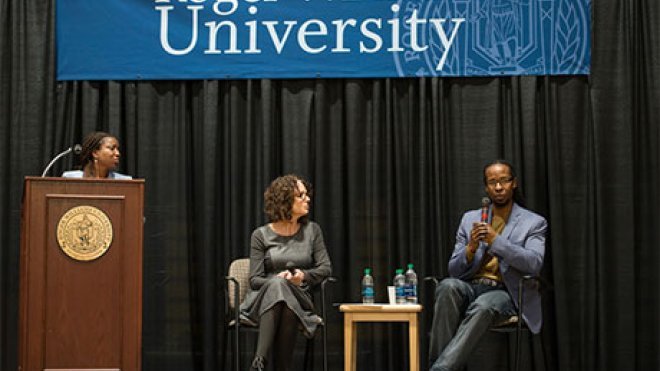Overcoming the Obstacles to Addressing Racism
Antiracist scholars Ibram Kendi and Robin DiAngelo urge RWU community to focus on outcomes of policies and to think of racism as a structure, not an event

BRISTOL, R.I. – Talking about racism can be incredibly difficult because so many Americans deny any racial intent behind policies that punish certain racial groups and because “white fragility” prompts so many people to lash out or shut down when confronted with even minimal amounts of racial stress.
Those were some of the ideas discussed on April 4 when antiracist scholars Ibram Kendi and Robin DiAngelo came to Roger Williams University as the capstone event in RWU’s year-long series, “Talking About Race, Gender and Power,” and as part of the President’s Distinguished Speaker Series.
Kendi, a professor and director of the Antiracist Research and Policy Center at American University, said it can be hard to define what a racist idea or policy is because everyone denies that their ideas and polices are racist.
“When they are charged with racism, they typically say things like: ‘I’m the least racist person you’ve ever interviewed, I’m the least racist person you’ve ever met,’ ” Kendi said. “So denial is sort of baked into the fabric of racism itself.”
He defines a racist idea as “any idea that suggests that a racial group is superior or inferior to another racial group in any way.” These days, he said, most people won’t come right out and say that a racial group is inferior, but they will talk about “what’s wrong with” a certain racial group and that amounts to saying the group is inferior.
He defines a racist policy as any policy that yields a racially unequal outcome. He noted that the definition hinges not on the stated intention – but on the quantifiable result.
“With every racist policy in American history, those who benefited or created those policies denied that those polices were racist,” Kendi said. “It’s quite easy to hide intention.”
For example, those who advanced the mass enslavement of black people rationalized the policy as “God’s law” or “nature law,” saying it was beneficial for black people or beneficial for America, he said.
Those who enacted and enforced Jim Crow laws made the case that those policies created “separate but equal” conditions – despite all evidence to the contrary, he said.
“And, of course, today those who are supporting mass-incarcerating or mass-deporting policies are denying that those policies are in any way racist,” Kendi said. “They are denying that they are trying to create a white ethno-state – from the White House to those who are marching in places like Charlottesville – because, of course, they state there’s this huge problem that these policies are solving.”
DiAngelo – who has written a book due out this summer titled “White Fragility: Why It’s So Hard to Talk to White People About Racism” – emphasized that racism is a structure, not an event.
“The dominant culture presents it as an event: Was he or wasn’t he a racist? Discuss,” DiAngelo said. “It’s a binary question: Only some people participate in racism and those are bad people. But if you understand racism as a structure, you ask different questions.”
She showed a slide with a long list of “state-sanctioned institutional racism” against African-Americans during U.S. history. It began with “Kidnapping and 246 years of enslavement, torture, rape and brutality.” It included “medical experimentation,” “lynching and mob violence” and “bans on marriage of interracial couples.” It included “employment discrimination,” “mass incarceration” and “testing/tracking/school funding.”
“African-Americans are not and have never been in position to do this to white people,” she said, referring the list. “White people have been and continue to be in a position to do this to African-Americans. So we can remove the word ‘reverse’ from this discussion. There is no such thing as ‘reverse racism.’ Racism by definition includes the weight of historical and institutional power behind it. It is a structure – not an event. It is a structure we are in, and none of us could be or have been exempt from its forces.”
Living in this structure, white people can react with a range of defensive behaviors when faced with the racial stress of having their positions, perspectives or advantages challenges, DiAngelo said, describing that as “white fragility.”
“So I will lash out, do whatever it takes to get you to stop doing that – burst into tears, withdraw, isolate, close down, be defensive, argue, explain, push back,” she said. “So it’s fragile in the sense we can barely handle the slightest challenge, but it’s not fragile at all in its impact. And I think white fragility actually functions as a kind of white racial bullying.”
So what can white people do next? DiAngelo showed another slide that, among other things, urged people to “Strive for humility. Listen! An opinion and informed knowledge are not the same.” It said, “There is no quick fix or solution to racism. It is complex, messy and requires a life-long commitment to continually identify and challenge.”